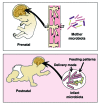Gut microbial communities modulating brain development and function
- PMID: 22743758
- PMCID: PMC3463494
- DOI: 10.4161/gmic.21287
Gut microbial communities modulating brain development and function
Abstract
Mammalian brain development is initiated in utero and internal and external environmental signals can affect this process all the way until adulthood. Recent observations suggest that one such external cue is the indigenous microbiota which has been shown to affect developmental programming of the brain. This may have consequences for brain maturation and function that impact on cognitive functions later in life. This review discusses these recent findings from a developmental perspective.
Figures


References
Publication types
MeSH terms
LinkOut - more resources
Full Text Sources
Other Literature Sources
